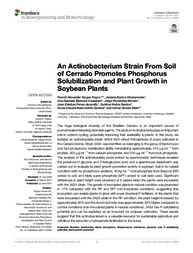An Actinobacterium strain from soil of Cerrado promotes Phosphorus solubilization and plant growth in soybean plants.
An Actinobacterium strain from soil of Cerrado promotes Phosphorus solubilization and plant growth in soybean plants.
Author(s): VARGAS HOYOS, H. A.; CHIARAMONTE, J. B; BARBOSA-CASTELIANI, A G.; , ORAIS, J. F.; PEREZ-JARAMILLO, J. E.; SANTOS, S. N.; QUEIROZ, S. C. do N. de; MELO, I. S. de
Summary: Abstract: The huge biological diversity of the Brazilian Cerrado is an important source of economically interesting microbial agents. The phylum Actinobacteria plays an important role in nutrient cycling, potentially improving their availability to plants. In this study, we isolated an actinobacteria (strain 3AS4) from wheat rhizospheres of crops cultivated in the Cerrado biome. Strain 3AS4 was identified as belonging to the genus Streptomyces and had phosphorus mobilization ability, mineralizing approximately 410 mg ml-1 from phytate, 300 mg ml-1 from calcium phosphate, and 200 mg ml-1 from rock phosphate. The analysis of the actinobacteria crude extract by spectrometric techniques revealed the presence of gluconic and 2-ketogluconic acid, and a greenhouse experiment was carried out to evaluate its plant growth promotion activity in soybean. Soil in its natural condition (with no phosphorus addition), 40 kg ha1 rock phosphate from Bayovar (RP) added to soil, and triple super phosphate (SPT) added to soil were used. Significant differences in plant height were observed at 6 weeks when the plants were inoculated with the 3AS4 strain. The growth of inoculated plants in natural condition was promoted in 17% compared with the RP and SPT non-inoculated conditions, suggesting that inoculation can enable plants to grow with lower chemical P fertilizers. In the plants that were inoculated with the 3AS4 strain in the RP condition, the plant height increased by approximately 80% and the shoot:root ratio was approximately 30% higher compared to control conditions (non-inoculated plants in natural conditions). 3AS4 has P-solubilizing potential and can be exploited as an inoculant for soybean cultivation. These results suggest that this actinobacterium is a valuable resource for sustainable agriculture and will allow the reduction of phosphate fertilization in the future.
Publication year: 2021
Types of publication: Journal article
Unit: Embrapa Environment
Observation
Some of Embrapa's publications are published as ePub files. To read them, use or download one of the following free software options to your computer or mobile device. Android: Google Play Books; IOS: iBooks; Windows and Linux: Calibre.
Access other publications
Access the Agricultural Research Database (BDPA) to consult Embrapa's full library collection and records.
Visit Embrapa Bookstore to purchase books and other publications sold by Embrapa.

